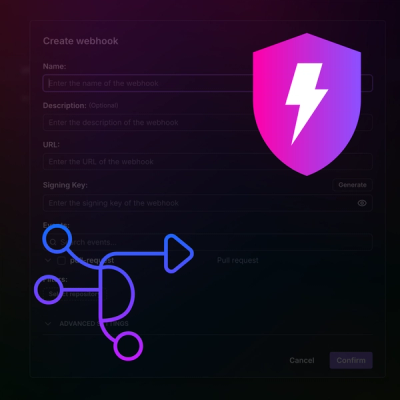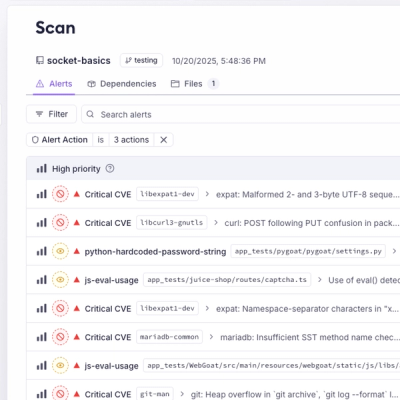
Product
Introducing Webhook Events for Pull Request Scans
Add real-time Socket webhook events to your workflows to automatically receive pull request scan results and security alerts in real time.
.. image:: https://img.shields.io/pypi/v/hootsweet :alt: PyPI
.. image:: https://img.shields.io/pypi/pyversions/hootsweet :alt: PyPI Versions
.. image:: https://img.shields.io/pypi/format/hootsweet :alt: PyPi Format
.. image:: https://requires.io/github/ciaranmccormick/hootsweet/requirements.svg?branch=develop :target: https://requires.io/github/ciaranmccormick/hootsweet/requirements/?branch=develop :alt: Requirements Status
.. image:: https://readthedocs.org/projects/hootsweet/badge/?version=latest :target: https://hootsweet.readthedocs.io/en/latest/?badge=latest :alt: Documentation Status
A python API for the HootSuite REST API.
.. code-block:: shell
pip install hootsweet
.. code-block:: python
from hootsweet import HootSweet
client_id = "Your-HootSuite-Client-ID"
client_secret = "Your-HootSuite-Client-Secret"
redirect_uri = "http://redirect.uri/"
def handle_refresh(token):
# callback function to save token to a database or file
save_token_to_db(token)
client = HootSweet(client_id, client_secret, redirect_uri=redirect_uri, refresh_cb=handle_refresh)
# Step 1 get authorization url from HootSuite
url, state = client.authorization_url()
# Step 2 go to url above and get OAuth2 code
token = client.fetch_token(code)
# client.token now contains your authentication token
# Step 3 (optional) refresh token periodically, this automatically calls handle_refresh
token = client.refresh_token()
# retrieve data from https://platform.hootsuite.com/v1/me
me = client.get_me()
# retrieve authenticated members organizations https://platform.hootsuite.com/v1/me/organizations
organizations = client.get_me_organizations()
.. code-block:: python
token = {
"access_token": "e9a90a81-xf2d-dgh3-cfsd-23jhvn76",
"token_Type": "Bearer",
"expires_in": 2592000,
"refresh_token": "82d82cf4-76gf-gfds-nt3k-lzpo12jg",
"scope": "offline"
}
client = HootSweet("client_id", "client_secret", token=token)
# Schedule a message
text = "A message"
social_profile_ids = ["1234", "12345"]
send_time = datetime(2020, 1, 1, 12, 40, 15)
message = client.schedule_message(text=text, social_profile_ids=social_profile_ids,
send_time=send_time)
# Get message
message = client.get_message(message_id="98765")
# Delete message
client.delete_message(message_id="98765")
HootSuite uses it's own AWS Bucket to add media to a message. To attach media to you message you need to first upload the media to HootSuite's bucket.
.. code-block:: python
token = {
"access_token": "e9a90a81-xf2d-dgh3-cfsd-23jhvn76",
"token_Type": "Bearer",
"expires_in": 2592000,
"refresh_token": "82d82cf4-76gf-gfds-nt3k-lzpo12jg",
"scope": "offline"
}
client = HootSweet("client_id", "client_secret", token=token)
mime_type = "image/png"
file_path = Path("/path/to/file.png")
file_size = file_path.stat().st_size
upload_details = client.create_media_upload_url(file_size, mime_type)
upload_url = upload_details["uploadUrl"]
media_id = upload_details["id"]
# The number of seconds you have to upload the media
expires_in = upload_details["uploadUrlDurationSeconds"]
# Upload the media
with file_path.open("rb") as f:
content = f.read()
headers = {"Content-Type": mime_type, "Content-Length": str(file_size)}
# Make sure that this request returns a 200
requests.put(upload_url, headers=headers, data=content)
# Schedule a message
text = "A message"
social_profile_ids = ["1234", "12345"]
send_time = datetime(2020, 1, 1, 12, 40, 15)
media = [{"id": media_id}]
message = client.schedule_message(text=text, social_profile_ids=social_profile_ids,
send_time=send_time, media=media)
FAQs
A python library for the HootSuite REST API.
We found that hootsweet demonstrated a healthy version release cadence and project activity because the last version was released less than a year ago. It has 1 open source maintainer collaborating on the project.
Did you know?

Socket for GitHub automatically highlights issues in each pull request and monitors the health of all your open source dependencies. Discover the contents of your packages and block harmful activity before you install or update your dependencies.

Product
Add real-time Socket webhook events to your workflows to automatically receive pull request scan results and security alerts in real time.

Research
The Socket Threat Research Team uncovered malicious NuGet packages typosquatting the popular Nethereum project to steal wallet keys.

Product
A single platform for static analysis, secrets detection, container scanning, and CVE checks—built on trusted open source tools, ready to run out of the box.